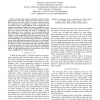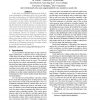10 search results - page 1 / 2 » Limiting the number of dirty cache lines |
DATE
2009
IEEE
13 years 11 months ago
2009
IEEE
Abstract—Caches often employ write-back instead of writethrough, since write-back avoids unnecessary transfers for multiple writes to the same block. For several reasons, however...
ISCA
2009
IEEE
13 years 11 months ago
2009
IEEE
This paper presents a novel technique, Memory Mapped ECC, which reduces the cost of providing error correction for SRAM caches. It is important to limit such overheads as processo...
DSD
2007
IEEE
13 years 8 months ago
2007
IEEE
In this study, we investigate different cache fault tolerance techniques to determine which will be most effective when on-chip memory cell defect probabilities exceed those of cu...
TC
2011
12 years 11 months ago
2011
—Aggressive technology scaling to 45nm and below introduces serious reliability challenges to the design of microprocessors. Since a large fraction of chip area is devoted to on-...
HPCA
2009
IEEE
14 years 5 months ago
2009
IEEE
In a Chip Multi-Processor (CMP) with private caches, the last level cache is statically partitioned between all the cores. This prevents such CMPs from sharing cache capacity in r...


